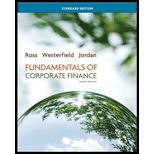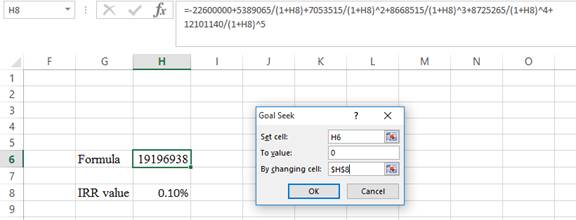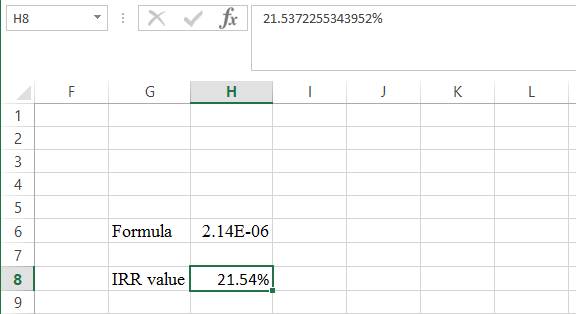
Concept explainers
To find: The
Introduction:
The variation between the present value of the cash outflows and the present value of the cash inflows are known as the net present value. In capital budgeting, the net present value is utilized to analyze the profitability of a project or investment. The rate of return (which compares the initial investment and the present value of net cash inflows)isreferred to as internal rate of return. This is also called actual rate of return.
Answer to Problem 32QP
The net present value is $2,098,569.18 and the internal
Explanation of Solution
Given information:
Company A projects the unit sale for the new 7 octave voice emulation implant as follows:
- Year 1’s unit sales is 81,000
- Year 2’s unit sales is 94,000
- Year 3’s unit sales is 108,000
- Year 4’s unit sales is 103,000
- Year 5’s unit sales is 84,000
The production implant needs $1,600,000 in the net working capital to begin their production activities. The extra net working capital investment for every year is equivalent to the 15% of the sales that is projected, which has to rise for the following year. The total fixed cost is $1,500,000 for a year, the unit price is $380, and the variable production cost is $265. The installation cost of the equipment is $21,000,000.
The equipment is qualified in the 7 Year MACRS
MACRS depreciation table for 7 year:
| MACRS Depreciation table for seven year | |
| Year | Seven year |
| 1 | 14.29% |
| 2 | 24.49% |
| 3 | 17.49% |
| 4 | 12.49% |
| 5 | 8.93% |
| 6 | 8.92% |
| 7 | 8.93% |
| 8 | 4.46% |
Computation of the net present value:
Computation of the
Table showing the cash inflows:
| Year | 1 | 2 | 3 | 4 | 5 |
| Ending book value | $17,999,100 | $12,856,200 | $9,183,300 | $6,560,400 | $4,685,100 |
| Sales | $30,780,000 | $35,720,000 | $41,040,000 | $39,140,000 | $31,920,000 |
| Less: Variable costs | $21,465,000 | $24,910,000 | $28,620,000 | $27,295,000 | $22,260,000 |
| Fixed costs | $1,500,000 | $1,500,000 | $1,500,000 | $1,500,000 | $1,500,000 |
| Depreciation | $3,000,900 | $5,142,900 | $3,672,900 | $2,622,900 | $1,875,300 |
| EBIT | $4,814,100 | $4,167,100 | $7,247,100 | $7,722,100 | $6,284,700 |
| Less: Taxes | $1,684,935 | $1,458,485 | $2,536,485 | $2,702,735 | $2,199,645 |
| Net income | $3,129,165 | $2,708,615 | $4,710,615 | $5,019,365 | $4,085,055 |
| Add: Depreciation | $3,000,900 | $5,142,900 | $3,672,900 | $2,622,900 | $1,875,300 |
| Operating cash flow | $6,130,065 | $7,851,515 | $8,383,515 | $7,642,265 | $5,960,355 |
| Net cash inflows: | |||||
| Operating cash flow | $6,130,065 | $7,851,515 | $8,383,515 | $7,642,265 | $5,960,355 |
| Change in net working capital | -$741,000 | -$798,000 | $285,000 | $1,083,000 | $1,771,000 |
| Capital spending | $0 | $0 | $0 | $0 | $4,369,785 |
| Total cash inflows | $5,389,065 | $7,053,515 | $8,668,515 | $8,725,265 | $12,101,140 |
Computations for the above table:
Formula to calculate the ending book value:
Computation of the ending book value for year 1:
Note:
- Sales are calculated by multiplying the price per unit with the unit sales of each year.
- Depreciation is calculated by multiplying the equipment’s installation cost with the MACRS depreciation rate for the particular year.
- The taxes are calculated by multiplying the earnings before tax for the specific year with the marginal tax rate.
- The change in the net working capital is calculated by subtracting the current year’s sales with the next year’s sales and multiplying it with the 15% (increased percentage).
Computation of the net working capital for year 5:
Computation of the ending book value:
Formula to calculate the after-tax salvage value:
Computation of the after-tax salvage value:
Formula to calculate the net present value:
Computation of the net present value:
Hence, the net present value is $2,098,569.18.
Computation of the internal rate of return:
The internal rate of return is calculated by the spreadsheet method.
Step 1:

- Type the formula of the internal rate of return in H6 in the spreadsheet and consider the IRRvalue as H8.
Step 2:

- Assume the IRRvalue as 0.10%.
Step 3:

- In the spreadsheet, go to data, and select the what-if analysis.
- In what-if analysis, select goal seek.
- In set cell, select H6 (the formula).
- The To value is considered as 0.
- The H8 cell is selected for the by changing cell.
Step 4:

- Following the previous step, click OK in the goal seek. The goal seek status appears.
Step 5:

- The IRRvalue appears to be 21.5372255343952%.
Hence, the internal rate of return is 21.54%.
Want to see more full solutions like this?
Chapter 10 Solutions
Fundamentals of Corporate Finance Standard Edition
 Essentials Of InvestmentsFinanceISBN:9781260013924Author:Bodie, Zvi, Kane, Alex, MARCUS, Alan J.Publisher:Mcgraw-hill Education,
Essentials Of InvestmentsFinanceISBN:9781260013924Author:Bodie, Zvi, Kane, Alex, MARCUS, Alan J.Publisher:Mcgraw-hill Education,

 Foundations Of FinanceFinanceISBN:9780134897264Author:KEOWN, Arthur J., Martin, John D., PETTY, J. WilliamPublisher:Pearson,
Foundations Of FinanceFinanceISBN:9780134897264Author:KEOWN, Arthur J., Martin, John D., PETTY, J. WilliamPublisher:Pearson, Fundamentals of Financial Management (MindTap Cou...FinanceISBN:9781337395250Author:Eugene F. Brigham, Joel F. HoustonPublisher:Cengage Learning
Fundamentals of Financial Management (MindTap Cou...FinanceISBN:9781337395250Author:Eugene F. Brigham, Joel F. HoustonPublisher:Cengage Learning Corporate Finance (The Mcgraw-hill/Irwin Series i...FinanceISBN:9780077861759Author:Stephen A. Ross Franco Modigliani Professor of Financial Economics Professor, Randolph W Westerfield Robert R. Dockson Deans Chair in Bus. Admin., Jeffrey Jaffe, Bradford D Jordan ProfessorPublisher:McGraw-Hill Education
Corporate Finance (The Mcgraw-hill/Irwin Series i...FinanceISBN:9780077861759Author:Stephen A. Ross Franco Modigliani Professor of Financial Economics Professor, Randolph W Westerfield Robert R. Dockson Deans Chair in Bus. Admin., Jeffrey Jaffe, Bradford D Jordan ProfessorPublisher:McGraw-Hill Education





